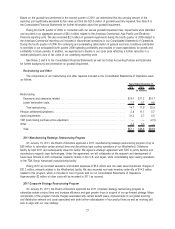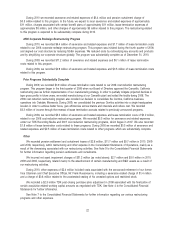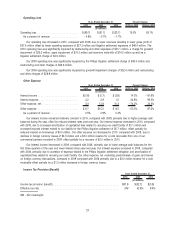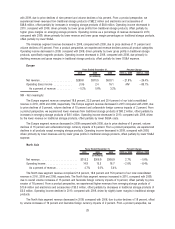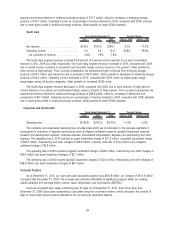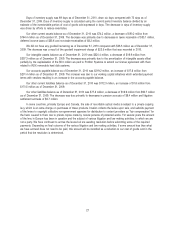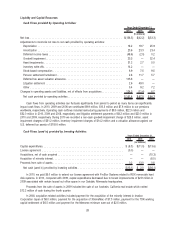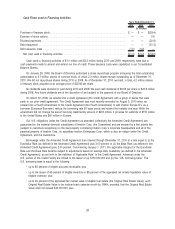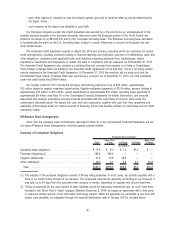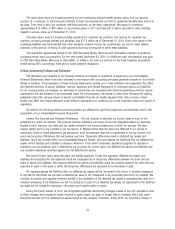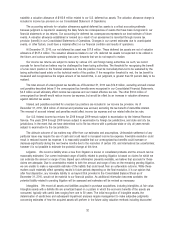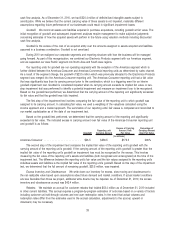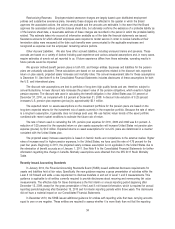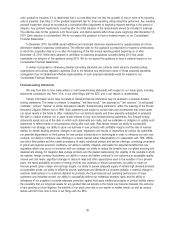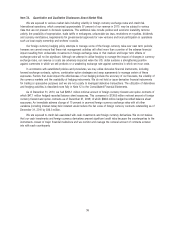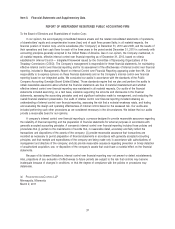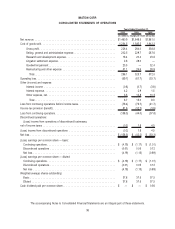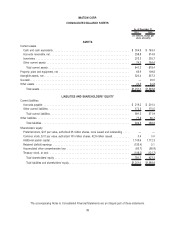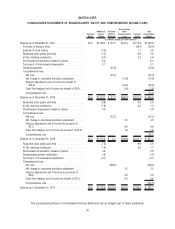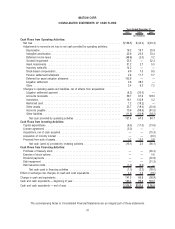Memorex 2010 Annual Report Download - page 34
Download and view the complete annual report
Please find page 34 of the 2010 Memorex annual report below. You can navigate through the pages in the report by either clicking on the pages listed below, or by using the keyword search tool below to find specific information within the annual report.The table above does not include payments for non-contributory defined benefit pension plans. It is our general
practice, at a minimum, to fund amounts sufficient to meet the requirements set forth in applicable benefits laws and local
tax laws. From time to time, we contribute additional amounts, as we deem appropriate. We expect to contribute
approximately $10 million to $15 million to our pension plans in 2011 and have $27.0 million recorded in other liabilities
related to pension plans as of December 31, 2010.
The table above does not include possible payments for uncertain tax positions. Our reserve for uncertain tax
positions, including accrued interest and penalties, was $17.5 million as of December 31, 2010. Due to the nature of the
underlying liabilities and the extended time often needed to resolve income tax uncertainties, we cannot make reliable
estimates of the amount or timing of cash payments that may be required to settle these liabilities.
The acquisition agreements related to the TDK Recording Media, Memcorp and XtremeMac business acquisitions
contained certain earn out provisions. For the year ended December 31, 2010, no additional cash consideration was paid
to TDK Recording Media, Memcorp or XtremeMac. In addition, the earn out periods for the three business acquisitions
ended during 2010; accordingly, there are no future payment obligations.
Critical Accounting Policies and Estimates
The discussion and analysis of our financial condition and results of operations is based upon our Consolidated
Financial Statements, which have been prepared in accordance with accounting principles generally accepted in the United
States of America. The preparation of these financial statements requires us to make estimates and judgments that affect
the reported amounts of assets, liabilities, revenue, expenses and related disclosures of contingent assets and liabilities.
On an on-going basis, we evaluate our estimates to ensure they are consistent with historical experience and the various
assumptions that are believed to be reasonable under the circumstances, the results of which form the basis for making
judgments about the carrying values of assets and liabilities that are not readily apparent from other sources. Actual
results may differ from these estimates under different assumptions or conditions and could materially impact our results of
operations.
We believe the following critical accounting policies are affected by significant judgments and estimates used in the
preparation of our Consolidated Financial Statements:
Income Tax Accruals and Valuation Allowances. We are required to estimate our income taxes in each of the
jurisdictions in which we operate. This process involves estimating our actual current tax obligations based on expected
taxable income, statutory tax rates and tax credits allowed in the various jurisdictions in which we operate. Tax laws
require certain items to be included in our tax returns at different times than the items are reflected in our results of
operations. Some of these differences are permanent, such as expenses that are not deductible in our tax returns, and
some are temporary differences that will reverse over time. Temporary differences result in deferred tax assets and
liabilities, which are included within our Consolidated Balance Sheets. We must assess the likelihood that our deferred tax
assets will be realized and establish a valuation allowance to the extent necessary. Significant judgment is required in
evaluating our tax positions, and in determining our provision for income taxes, our deferred tax assets and liabilities and
any valuation allowance recorded against our net deferred tax assets.
We record income taxes using the asset and liability approach. Under this approach, deferred tax assets and
liabilities are recognized for the expected future tax consequences of temporary differences between the book and tax
basis of assets and liabilities. We measure deferred tax assets and liabilities using the enacted statutory tax rates that are
expected to apply in the years in which the temporary differences are expected to be recovered or paid.
We regularly assess the likelihood that our deferred tax assets will be recovered in the future. A valuation allowance
is recorded to the extent we conclude a deferred tax asset is not considered to be more-likely-than-not to be realized. We
consider all positive and negative evidence related to the realization of the deferred tax assets in assessing the need for a
valuation allowance. If we determine we will not realize all or part of our deferred tax assets, an adjustment to the deferred
tax asset will be charged to earnings in the period such determination is made.
During the fourth quarter of 2010, we recognized significant restructuring charges related to our U.S. operations. Due
to these charges and cumulative losses incurred in recent years, we were no longer able to conclude that it was more-
likely-than-not that our U.S. deferred tax assets would be fully realized. Therefore, during 2010, we recorded a charge to
31


